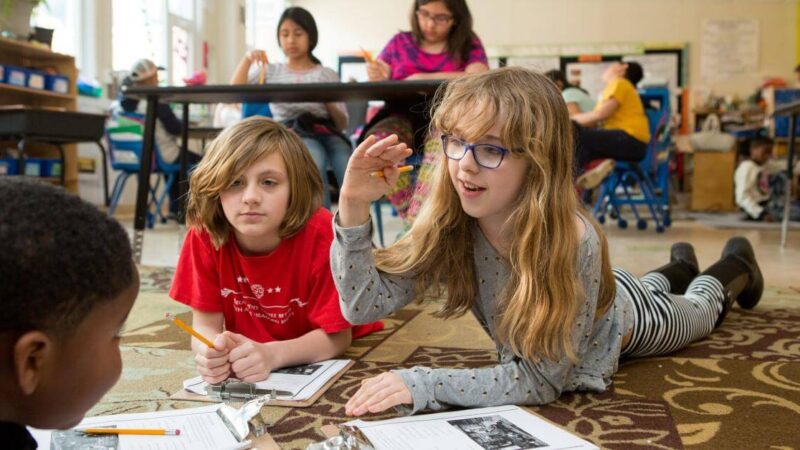Coordination in Education Enhancing Learning Environments

Coordination in education refers to the collaborative efforts among different partners inside the education system to guarantee the smooth and compelling working of educational institutions and to realize particular instructive objectives. It includes the arrangement of resources, policies, and techniques to form a cohesive and strong environment for students’ learning and advancement.
Coordination in education plays a vital part in upgrading learning situations. Successful coordination includes collaboration among different partners inside the instruction framework, counting teachers, students, guardians, chairmen, and policymakers. When done well, it can lead to progressed instructive results and a more conducive learning environment.
Coordination in education is basic for making an all-encompassing and compelling learning environment. It includes collaboration among different partners to adjust educational programs, apportion assets proficiently, give proficient improvement, lock in guardians and communities, guarantee data-driven decision-making, and address issues related to security, inclusion, and technology integration. When done viably, coordination upgrades the general quality of instruction and contributes to superior student results.
Why is Coordination in Education important?
Coordination in education is critical for a variety of reasons because it plays an essential part in guaranteeing the adequacy, effectiveness, and general victory of instructive frameworks. Here are a few key reasons why coordination in education is crucial.
1-Consistency and Clarity
Coordination makes a difference in setting up clear and steady instructive objectives, standards, and desires over all levels of the education system. This clarity guarantees that students get a coherent and standardized learning encounter.
2-Effective Curriculum Development
Coordination among curriculum developers, teachers, and chairmen ensures that the educational programs are well-designed and adjusted with instructive destinations. This leads to an educational program that’s important, locks in, and conducive to understudy learning.
3-Professional Development
Facilitated proficient development openings for teachers and staff offering assistance to remain current with the best homes, educating techniques, and innovation. This progressing preparation improves the quality of instruction and benefits understudy learning.
4-Inclusive Education
Collaboration among teachers, extraordinary instruction experts, and support staff is fundamental for giving comprehensive instruction to understudies with assorted needs. Coordination guarantees that understudies with disabilities get the fundamental accommodations and support inside standard classrooms.
5-Parent and Community Engagement
Facilitated efforts encourage the dynamic inclusion of guardians and the community within the instructive preparation. Locked-in guardians and community individuals can give important back, assets, and inspiration to understudies.
6-Data-Informed Decision-Making
Coordination encourages information collection and sharing related to understudy execution and results. Analyzing this information permits teachers and directors to form educated choices, educational modules, alterations, guidelines techniques, and meditations to support struggling students.
7-Technology Integration
Collaboration between IT departments and teachers guarantees the successful integration of technology into the learning handle. This may move forward to instructive assets, upgrade educating strategies, and prepare understudies for the advanced age.
8-Policy Development
Coordination among policymakers, teachers, and chairmen is vital for the improvement and execution of instruction approaches that are evidence-based, evenhanded, and responsive to advancing instructive needs.
9-Continuous Improvement
Coordination supports the progressing review and change of educational practices and approaches. It permits instruction frameworks to adjust to changing circumstances, rising patterns, and advancing student needs.
10-Student Success
Eventually, coordination in education is driven by the objective of upgrading understudy victory. By adjusting assets, approaches, and methodologies, coordination makes a difference and makes an environment where understudies can flourish scholastically and actually.
How does coordination in education enhance learning environments?
Coordination in education plays an essential part in upgrading learning situations by cultivating collaboration among different partners inside the education system. When instructive education, chairmen, teachers, guardians, and communities work together in a facilitated way, a few key benefits develop. To begin with, first, it guarantees that the educational module is well-aligned with instructive objectives and guidelines, making a centered and important learning encounter for students.
Productive asset allocation, another item of coordination, guarantees that schools have the essential apparatuses and workforce to supply a quality education. Furthermore, facilitated endeavors empower the proficient advancement of teachers, guaranteeing they remain up-to-date with the best homes and educating strategies.
By locking in guardians and the community, coordination makes a strong organization for students, whereas data-driven decision-making recognizes ranges for advancement and tailors instruction to meet personal needs. In general, coordination in instruction makes an environment where all elements work in agreement to supply understudies with the finest conceivable learning encounter, eventually driving to progressed instructive results and a more conducive learning environment.
Here’s an exploration of how coordination can enhance learning environments:
1. Curriculum Integration
- Interdisciplinary Learning: Coordination among teachers across different subjects can foster interdisciplinary learning, where students connect concepts from various disciplines, promoting a deeper understanding and application of knowledge.
- Curriculum Alignment: Ensuring that the curriculum across grades and subjects is aligned helps in building upon previously acquired knowledge, avoiding redundancy, and preparing students for future learning challenges.
2. Teaching Methodologies
- Collaborative Planning: Teachers working together to plan lessons and share teaching strategies can lead to more innovative and effective teaching methodologies that cater to diverse learning styles.
- Professional Development: Coordinated efforts to provide teachers with ongoing professional development opportunities ensure that instructional practices stay current with educational research and technology trends.
3. Technology Integration
- Educational Technology Tools: Coordinating the use of technology in the classroom ensures that digital tools complement the learning objectives and are used effectively to enhance education rather than distract from it.
- Digital Literacy: A coordinated approach to teaching digital literacy skills across subjects prepares students to navigate the digital world responsibly and effectively.
4. Administrative Support
- Resource Allocation: Effective coordination between school administration and teachers ensures that classrooms are well-resourced and that teachers have the materials and support they need to deliver high-quality education.
- Policy Implementation: Administrators play a crucial role in implementing educational policies that support teaching and learning. Coordinated efforts help in addressing challenges and leveraging opportunities for improvement.
5. Inclusive Education
- Special Education Needs (SEN): Coordination among SEN specialists, teachers, and parents ensures that students with special educational needs receive tailored support, accommodations, and modifications necessary for their success.
- Cultural Responsiveness: Coordinating efforts to embrace cultural diversity within the school community enhances inclusivity and provides all students with a sense of belonging.
6. Parental and Community Involvement
- Engagement Strategies: Coordinated strategies to engage parents and the community in educational activities can enrich the learning experience and provide students with additional support and resources.
- Communication Channels: Establishing effective communication channels between the school and home ensures that parents are informed and involved in their child’s education, fostering a supportive learning environment outside the classroom.
7. Student Support Services
- Counseling and Guidance: Coordination among counselors, teachers, and administrators ensures that students receive the emotional and academic support they need, promoting well-being and academic success.
- Extracurricular Activities: Coordinated efforts to offer a range of extracurricular activities allow students to explore interests beyond the classroom, develop new skills, and form social connections.
Frequently Asked Questions
What is coordination in education, and why is it vital for improving learning environments?
Coordination in education refers to the collaborative efforts of different partners, such as teachers, students, guardians, directors, and community individuals, to form an environment that bolsters learning and cultivates scholastic and individual development. It’s vital since it advances successful communication, asset assignment. The execution of best homes, eventually driving to make strides in learning results.
How can parents and caregivers contribute to coordination in education and make strides in learning environments?
Parents can contribute by effectively locking in their child’s education, going to parent-teacher conferences, communicating with instructors, and giving back at home. Their association cultivates a sense of association and a steady domestic learning environment.
How can technology integration be facilitated to upgrade learning environments?
Successful technology integration includes planning efforts between teachers, IT offices, and chairmen. It incorporates giving access to computerized assets, preparing instructors on innovation devices. And guaranteeing that technology is utilized in ways that improve instruction and learning.
How does coordination in education address the needs of students with incapacities or uncommon educational needs?
Coordination is significant for making and actualizing Individualized Education Programs (IEPs) for students with disabilities. It includes collaboration among uncommon education teachers, standard classroom teachers. The bolster staff to supply custom-fitted back and housing to meet the interesting needs of these understudies.
Conclusion
In conclusion, effective coordination in education may be a foundation for making improved learning situations. When teachers, students, guardians, chairmen, and communities work together agreeably, it clears the way for educational module consistency, proficient development, data-driven enhancements, and all-encompassing back for understudies. This cooperative energy cultivates an instructive biological system where students thrive, learn successfully, and prepare for a fruitful future. Coordination isn’t just a technique but a commitment to sustaining the most excellent conceivable learning situations for all learners.



